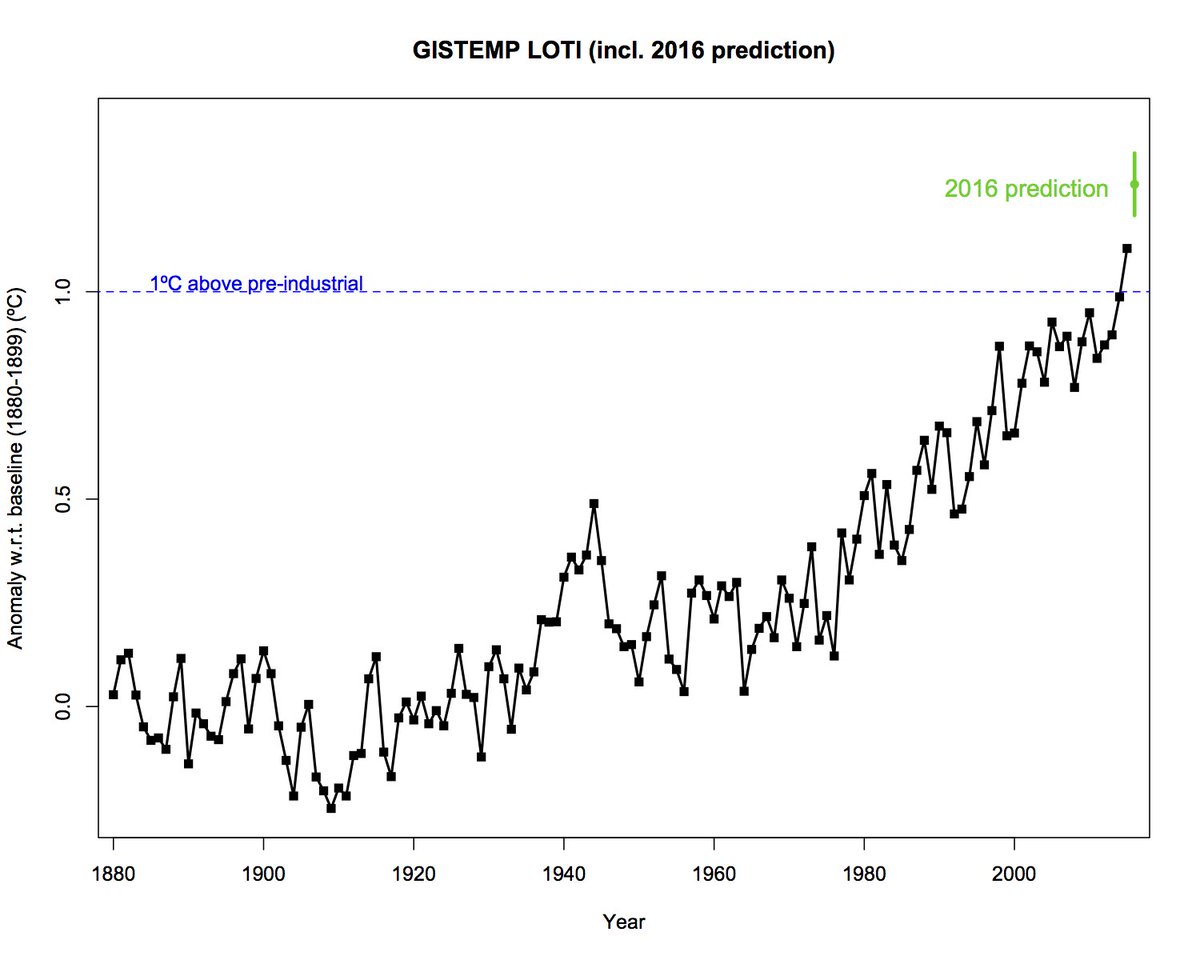
Global average temperature anomalies. Image: Weatherbell analytics
August 2016 was the warmest such month on record, according to preliminary data released by NASA on Monday. This further ensures that the year will beat 2015 for the dubious title of the warmest year on record...
In addition, August tied July for the distinction of being the hottest month of any month on record, according to a NASA statement released on Monday. This was unexpected, since the planet's seasonal temperature cycle typically peaks in July, but global warming and natural climate variability has thrown that off, at least for this year.
The temperature record also means that those in the Northern Hemisphere can say they just lived through the hottest summer on Earth, while residents of the Southern Hemisphere would refer to it as the globe's warmest winter.
According to NASA's Goddard Institute for Space Studies (GISS) in New York, readings from more than 6,300 thermometers, buoys and other sources show that August had a global average surface temperature departure from average of 0.98 degrees Celsius, or 1.76 degrees Fahrenheit above average.
August 2016 is now the 11th straight month to set a warm temperature record, according to NASA's data.
The month shattered the previous mark for the warmest August, which was August of 2014, when global average temperatures were 0.82 degrees Celsius above average, based on NASA readings. The third-warmest August occurred last year.
The warmth is already having consequences all over the world, from polar ice caps to the floor of overheated seas.
In the Arctic, sea ice has melted to the second-lowest ice extent on record, with open water approaching the geographic North Pole.

Global average surface temperatures during 2016 compared to other years. Image: Gavin schmidt/nasa
In the U.S., much of the country had a record warm or near record warm summer, particularly in the northeast as well as Alaska. The June through August period was the fifth-hottest June through August period on record for the country, according to the National Oceanic and Atmospheric Administration (NOAA). NOAA will release its own global temperature statistics for August in the coming days, since it uses slightly different methods to calculate the global average.
The presumed record warm year of 2016 has brought flood disasters to the U.S., including a billion-dollar flood in Louisiana in August. Typically hot locations, such as India, Kuwait and Iraq, set new benchmarks for what constitutes their hottest days.
GISTEMP analysis for August 2016 - Another month, another record: http://go.nasa.gov/2cR3hlr
The heat in the past two years has been produced by human-caused climate change with a boost from an El Niño event, which has now faded.
Yet the record heat marches on. A predicted La Niña event, which would have been characterized by unusually cool ocean temperatures in parts of the equatorial tropical Pacific Ocean, has largely been a no-show.
That event could have tapped the brakes on the planet's warm streak, at least temporarily, but the likelihood of such an event developing during 2016 has dropped considerably. Federal climate forecasters dropped the "La Niña Watch" last week.
Global temperature departures from average had been declining from March through June, which was consistent with a coming La Niña. This led to the possibility that the record-breaking warm streak would come to an end.
However, the anomalies have ticked back up since then.
While July had a temperature departure from average of 0.85 degrees Celsius, or 1.53 degrees Fahrenheit, both July and August had higher anomalies. This may indicate that Earth's fever is not breaking, even in the short-term.
What's worse, from the point of view of climate activists, scientists and policymakers, is the fact that the temperature anomalies seen this year have occasionally ticked up to limits set by the Paris Climate Agreement.
That agreement, negotiated in December of 2015 and expected to enter force by the end of the year, seeks to hold global average surface temperatures to "well below" 2 degrees Celsius, or 3.6 degrees Fahrenheit, relative to preindustrial levels. It also contains an aspirational goal of limiting warming to at or below 1.5 degrees Celsius, or 2.7 degrees Fahrenheit, above preindustrial levels.
That lower number was a major priority of small island nations, which face an existential threat from rising seas. February's global average surface temperature was 1.32 degrees Celsius, which was uncomfortably close to 1.5 degrees when viewed in the Paris Agreement context.
Prospects for a record 2016 given Jan-Aug data remain v. high (> 99%)
For climate scientists, what matters is the long-term trend over decades to centuries, making monthly records much less significant compared to the steady increase in temperatures throughout the 20th and 21st centuries.
"Monthly rankings, which vary by only a few hundredths of a degree, are inherently fragile," said GISS Director Gavin Schmidt, in a statement. "We stress that the long-term trends are the most important for understanding the ongoing changes that are affecting our planet."
The long-term record shows an unmistakable upward trend in global temperatures, with warming accelerating in the oceans and atmosphere in recent decades.
09/12/2016
source: http://mashable.com/
original story HERE
Get more of The Global Warming Blog. Bookmark this page and sign up for the blog’s free RSS Feed. Sign up for free Global Warming Blog by clicking here. You will automatically be emailed a regular summary of the latest global warming headlines.
To help do something about the climate change and global warming emergency, click here.
Sign up for our free Global Warming Blog by clicking here. (In your email, you will receive critical news, research, and the warning signs for the next global warming disaster.)
To share this blog post: Go to the Share button to the left below.






Be the first to comment
Sign in with